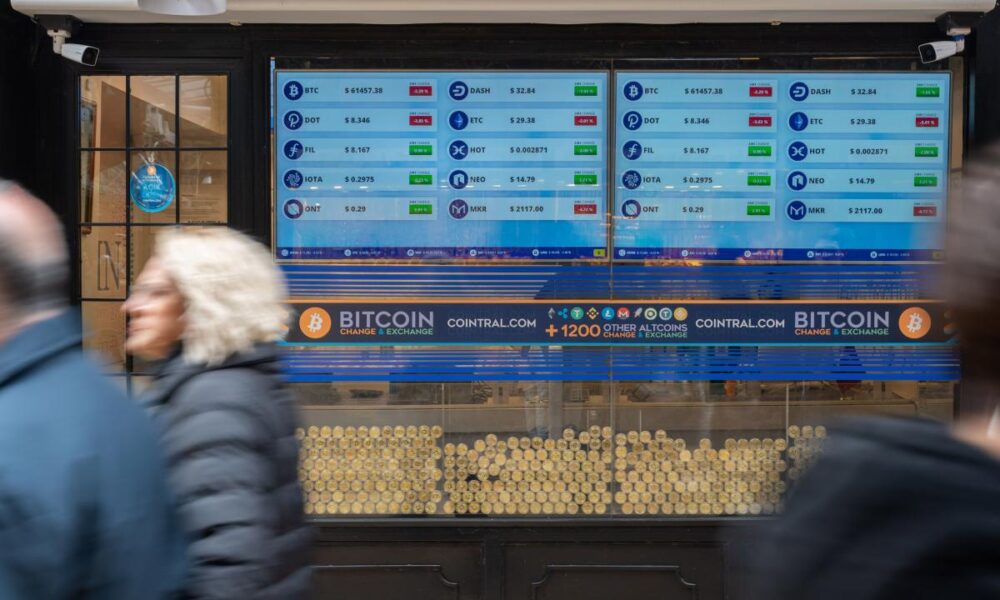Bitcoin
Bitcoin developers are touting ‘programmability’ as the catalyst for the next rally

(Bloomberg) — After the long-awaited launch of U.S. Bitcoin exchange-traded funds in January and the every-four-year software update called “halving” last month, the big question for many crypto investors is has been: What will drive the biggest cryptocurrency’s next rally?
Bloomberg’s Most Read
Many developers think they have the answer: add programmability to the Bitcoin blockchain. Today, Bitcoin is seen by many as digital gold – a token you hold for appreciation but can’t do much else with. While you can use its biggest rival, Ether, to exchange currencies and earn yield on the Ethereum network, the Bitcoin blockchain lacks the ability to easily support applications through so-called smart contract functionality that enables features such as self-executing agreements stored in the Ethereum network. blockchain.
For years, developers have tried to fix this intentional design flaw in a variety of ways. They have built “Layer 2” Bitcoin networks, like Lightning, designed to scale Bitcoin for applications like payments. Some have proven to be unreliable, and so-called bridges – software infrastructure for moving tokens between networks – have been prone to hacks, making many users hesitant to use them. And many Bitcoiners are not interested in using the tokens for payment anyway, and hold them with the expectation that long-term staking prices will rise in what has become known as “hodling.” However, without a new catalyst to maintain investor enthusiasm for Bitcoin, the original cryptocurrency has retreated from its all-time high of nearly $74,000 set in March.
Things changed recently, however, when Bitcoin Ordinals – a way to create non-fungible tokens by embedding data in satoshis, as the smallest denomination of Bitcoin is called – began last year. Soon after, an anonymous developer named Domo proposed BRC-20 tokens, which use the same inscription mechanism to issue tokens on the Bitcoin blockchain. This, in turn, has caused teams of developers to look for ways to enable even greater programmability of Bitcoin. The Bitcoin community is considering proposals like OP_CAT, which would be a software upgrade to the network itself and make programming easier to implement. Approaches being worked on include one from a team Domo is involved with, the Layer 1 Foundation. Another approach, from startup Arch, has just raised US$7 million in a round led by Multicoin Capital.
The story continues
“It’s a huge unlock for Bitcoin,” said Kyle Samani, co-founder of Multicoin. “It’s very good for users.”
Expected to open to all developers later this month, Arch runs an application platform on top of Bitcoin that uses software that will potentially allow applications from the Solana network to be ported to Bitcoin, said Arch CEO Matt Mudano. About 20 teams of developers are already building applications for functions such as lending against Ordinals, as well as decentralized exchanges and stablecoins, he said.
Meanwhile, the Layer 1 Foundation is building a programmable module for the so-called BRC-20 metaprotocol, which is essentially just messages stored in code layered on the Bitcoin blockchain. An indexer can find these messages and perform calculations in a similar way to smart contracts on Ethereum. Since Bitcoin has much longer block confirmation times than Ethereum – 10 minutes versus 12 seconds currently – this leaves more time to perform calculations, “we can actually do more,” said Eril Ezerel, founder of Best in Slot, Ordinals aggregator and explorer.
“It’s like chapter two of cryptography, Ezerel said. “It’s big. It makes us question how we build things.” Although building with metaprotocols is simpler, it is sufficient to support most financial applications, he said.
Not everyone in the Bitcoin programming community is convinced that this is the future of cryptocurrency. Jeff Garzik, former Bitcoin core developer and co-founder of crypto infrastructure and application builder Bloq, expects Layer 2s to eventually win out, as using them for transactions will be cheaper than running applications on Bitcoin.
“Bitcoin’s programmability is increasing – by virtue of these new Bitcoin L2s expanding Bitcoin’s reach,” said Garzik, who is working on a merger of Bitcoin and Ethereum Layer 2. “This simultaneously boosts the Ethereum ecosystem and also recently competes with the Ethereum ecosystem.”
Still, new ventures are betting that this new type of programmability could lead to an influx of decentralized financial applications on Bitcoin. Currently, the total value of tokens locked in the Bitcoin DeFi market is around $1.1 billion, compared to $52.7 billion for Ethereum, according to DeFi data tracker Llama.
“Bitcoin’s DeFi ecosystem could grow to become the largest of all cryptocurrencies,” said Toby Lewis, founder of OrdinalsBot. “It is possible that the Bitcoin DeFi ecosystem could grow to trillions of dollars in market value in the coming years, and it appears to be one of the main drivers of crypto growth this cycle.”
And if demand materializes, it could possibly be the next catalyst that Bitcoin investors seem to be waiting for.
Bloomberg Businessweek Most Read
©2024 Bloomberg LP
